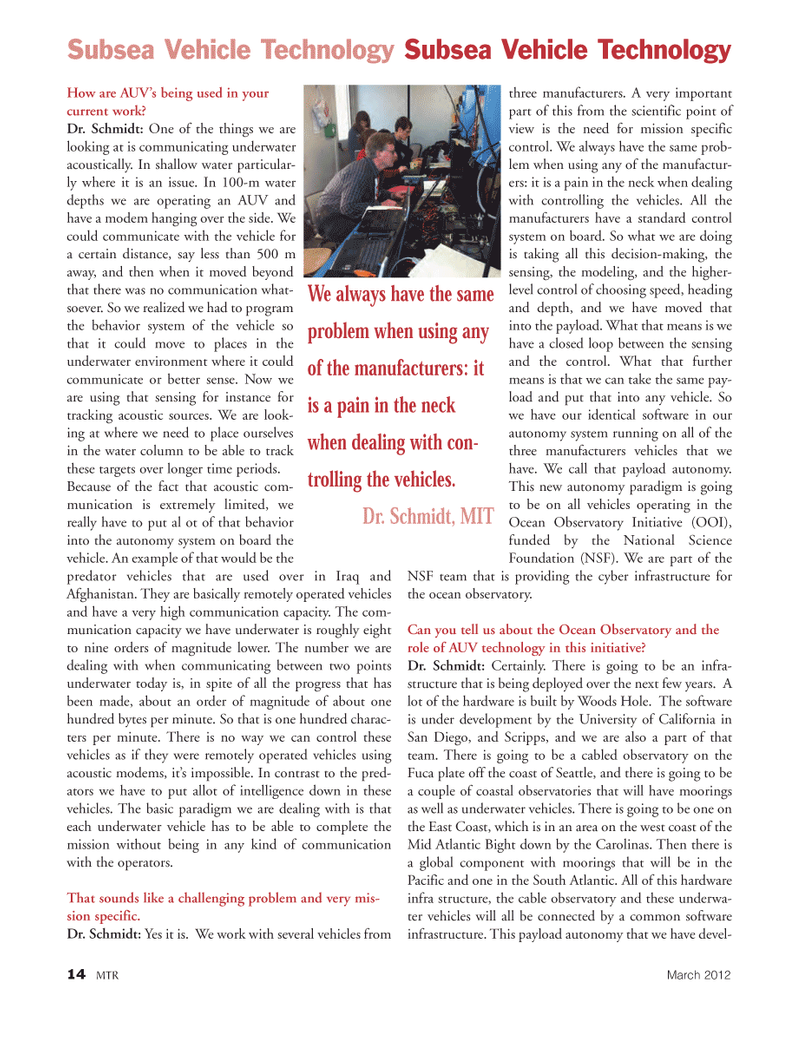
Page 14: of Marine Technology Magazine (March 2012)
Subsea Vehicle Report – Unmanned Underwater Systems
Read this page in Pdf, Flash or Html5 edition of March 2012 Marine Technology Magazine
14MTRMarch 2012 How are AUV?s being used in your current work? Dr. Schmidt: One of the things we are looking at is communicating underwater acoustically. In shallow water particular- ly where it is an issue. In 100-m water depths we are operating an AUV and have a modem hanging over the side. We could communicate with the vehicle for a certain distance, say less than 500 m away, and then when it moved beyond that there was no communication what- soever. So we realized we had to program the behavior system of the vehicle so that it could move to places in the underwater environment where it could communicate or better sense. Now we are using that sensing for instance for tracking acoustic sources. We are look- ing at where we need to place ourselves in the water column to be able to trackthese targets over longer time periods. Because of the fact that acoustic com- munication is extremely limited, we really have to put al ot of that behavior into the autonomy system on board the vehicle. An example of that would be the predator vehicles that are used over in Iraq and Afghanistan. They are basically remotely operated vehicles and have a very high communication capacity. The com- munication capacity we have underwater is roughly eight to nine orders of magnitude lower. The number we are dealing with when communicating between two points underwater today is, in spite of all the progress that has been made, about an order of magnitude of about one hundred bytes per minute. So that is one hundred charac- ters per minute. There is no way we can control these vehicles as if they were remotely operated vehicles using acoustic modems, it?s impossible. In contrast to the pred- ators we have to put allot of intelligence down in these vehicles. The basic paradigm we are dealing with is that each underwater vehicle has to be able to complete the mission without being in any kind of communicationwith the operators.That sounds like a challenging problem and very mis- sion specific.Dr. Schmidt: Yes it is. We work with several vehicles from three manufacturers. A very important part of this from the scientific point of view is the need for mission specific control. We always have the same prob- lem when using any of the manufactur-ers: it is a pain in the neck when dealingwith controlling the vehicles. All the manufacturers have a standard control system on board. So what we are doing is taking all this decision-making, thesensing, the modeling, and the higher-level control of choosing speed, heading and depth, and we have moved that into the payload. What that means is we have a closed loop between the sensing and the control. What that further means is that we can take the same pay- load and put that into any vehicle. So we have our identical software in our autonomy system running on all of the three manufacturers vehicles that we have. We call that payload autonomy. This new autonomy paradigm is going to be on all vehicles operating in the Ocean Observatory Initiative (OOI), funded by the National Science Foundation (NSF). We are part of the NSF team that is providing the cyber infrastructure for the ocean observatory. Can you tell us about the Ocean Observatory and the role of AUV technology in this initiative? Dr. Schmidt: Certainly. There is going to be an infra- structure that is being deployed over the next few years. A lot of the hardware is built by Woods Hole. The software is under development by the University of California in San Diego, and Scripps, and we are also a part of that team. There is going to be a cabled observatory on the Fuca plate off the coast of Seattle, and there is going to be a couple of coastal observatories that will have moorings as well as underwater vehicles. There is going to be one on the East Coast, which is in an area on the west coast of the Mid Atlantic Bight down by the Carolinas. Then there is a global component with moorings that will be in thePacific and one in the South Atlantic. All of this hardware infra structure, the cable observatory and these underwa- ter vehicles will all be connected by a common software infrastructure. This payload autonomy that we have devel- Subsea Vehicle Technology Subsea Vehicle Technology We always have the same problem when using any of the manufacturers:it is a pain in the neckwhen dealing with con-trolling the vehicles. Dr. Schmidt, MIT MTR#2 (1-17):MTR Layouts 2/21/2012 10:13 AM Page 14

 13
13

 15
15
